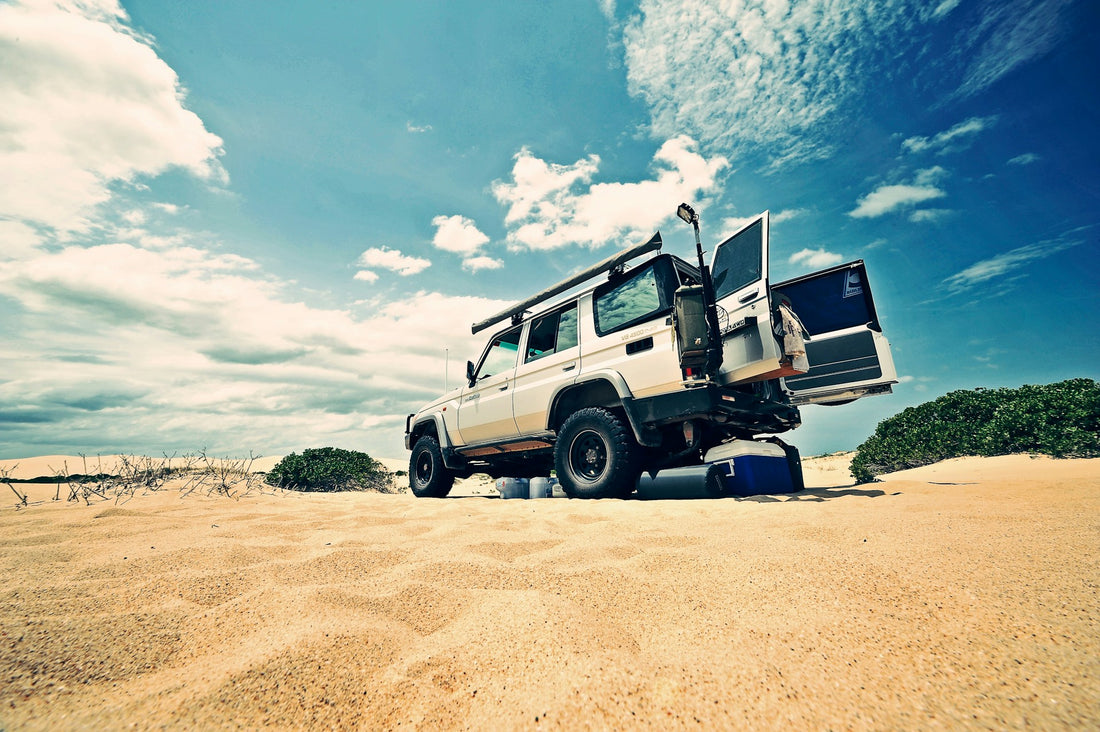Heading out on a 4WD adventure is exciting, but safety comes first. Just like prepping for any trip, a quick checklist can really help. That's why we've put together a simple guide to make sure you're ready for whatever comes your way. From checking your vehicle to packing the right gear, we've got you covered for a smooth journey.
Vehicle Inspection
When it comes to off-road adventures or driving in challenging terrains, a well-maintained and properly equipped 4WD vehicle is critical for your safety. Before any journey, it is essential to perform a thorough inspection of your vehicle to make sure that everything is in proper working order.
Here is a comprehensive 4WD safety checklist for conducting a vehicle inspection:
-
Engine: Begin with a thorough examination of your engine. Remove any dust or mud buildup and check for leaks or cracks, which could indicate underlying issues. Check all engine fluids are topped up, including oil, brakes, coolant, power steering, wipers, and transmission. Assess the condition of fan belts and hoses, and address any signs of wear or damage promptly.
-
Electricals: Verify the functionality of your auxiliary battery and auxiliary gear such as solar panels. Inspect connections for cleanliness and integrity, and carry spare fuses and essential electrical tools for emergencies.
-
Tyres: Thoroughly inspect tyre air pressure and tread at a local service station, ensuring all nuts on wheels are tightened, and don't forget to check the spare tyre.
-
Brakes: Conduct a comprehensive inspection of your brakes for corrosion, warping, and any signs of damage. Clean brake components and ensure brake lines are intact, with no leaks. Confirm that both brake lights are operational with the assistance of a companion.
-
Suspension: Pay close attention to your suspension system, listening for unusual sounds and inspecting components like tie rod ends, ball joints, and bushes for signs of wear or damage.
-
Frame and Exterior: Clean your vehicle inside and out to facilitate the identification of cracks, rust, or damage. Inspect all accessories for proper attachment, including bull bars, fog lamps, and recovery gear.
-
Recovery Gear: Check the condition of your winch, ensuring it is neatly spooled and free of visible damage. Verify the functionality of other recovery gear essential for off-road excursions.
-
Lights: Ensure proper installation and wiring of all lights, keeping them clean and free from debris to maintain optimal functionality.
Quick 4×4 Maintenance Checklist
- Check engine oil, transmission oil, radiator coolant, brake fluid, and wiper fluid.
- Inspect hoses, fan belts, air filters, seat belts, and brake pads.
- Tighten drive shaft u-bolts and lug bolts.
- Grease all fittings and perform a visual inspection of the entire vehicle for loose bolts or nuts.
Personal Safety Items & Communication
Prioritise personal safety by equipping yourself with essential items such as a first aid kit, fire extinguisher, 2-way radio, torch, map/GPS, and jump starter. Familiarise yourself with basic first aid procedures and ensure your communication devices are charged and functional.
For more information about 4WD communication devices, you can read up on our ultimate guide to UHF Radios.
Recovery Gear
4WD recovery gear consists of a variety of tools and equipment. Designed to help you recover your vehicle, there’s no need to worry if you’re stuck in challenging off-road situations.
The most likely problem is becoming stuck in deep mud, sand, or other precarious spots. Without the right gear, getting yourself unstuck can be almost impossible, and you'll be forced to contact a towing company for help.
Quick 4×4 Recovery Gear Checklist
Tow Straps: Tow straps are heavy-duty straps designed to help pull a stuck vehicle out of a predicament. They are typically made of nylon or polyester and can handle a significant amount of tension.
Hi-Lift Jacks: Hi-lift jacks are versatile tools that can be used for lifting, winching, clamping, and spreading. They're especially handy for changing tires or lifting your vehicle out of a rut.
Recovery Straps: Recovery straps are different from tow straps. They're stretchy and are designed to store kinetic energy, allowing for a more controlled and gentle pull when recovering a stuck vehicle.
Shackles: Shackles are used to connect straps, cables, or winch lines to anchor points on your vehicle. They come in various shapes, sizes, and are an essential part of the recovery process.
Winches: Winches are motorised devices that pull your vehicle out of a tough spot. They're often mounted on the front of 4WD vehicles and can be a game-changer when you're stuck.
Camping Essentials & Equipment
Prepare for camping adventures with essential gear like tents/swags, camping stove, cooking utensils, food, water, power supply, lanterns/torches, bedding, portable fridge/freezer, camp chairs, and shower/toilet facilities. And don't forget to stock up on water, food, sunscreen, insect repellent, and other personal essentials to sustain you throughout your journey.
Quick 4×4 Camping Gear Checklist
- Bags and Luggage
- Cooking and Kitchen
- Furniture
- Heating and Cooling
- Spare Parts and Accessories
- Camping Lights
- Canopies and Trays
Camping Adventures is your preferred one-stop-shop if you are looking to start or advance your camping adventure. We provide honest expert advice when choosing a camper trailer, and fitting out your 4x4 and offer a diverse range of camping, 4x4 and RV accessories.
Shop 4WD Accessories and Camping Gear at Camping Adventures
If you are an avid outdoor enthusiast who loves to explore off-road terrains, having a reliable 4WD vehicle is essential. However, it is equally important to ensure that your vehicle is properly equipped with the necessary accessories and gear to enhance safety during your adventures. At Camping Adventures, we offer a wide range of 4WD accessories and camping gear that will help you make the most out of your offroad experiences while keeping you safe.
Happy trails!







